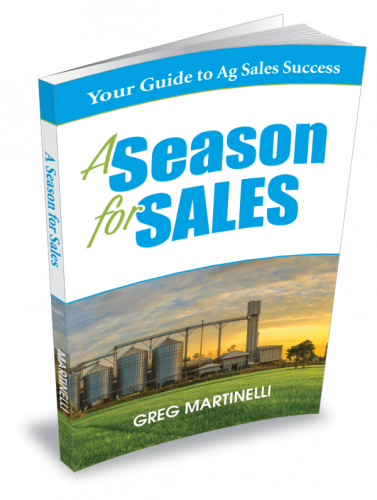3 sales math equations to make you more successful
when selling in agribusiness
Several years ago, I wrote the blog, “Sales Math”. The reason I wrote it was the lack of understanding that I saw in new and experienced salespeople alike. When coaching or training a salesperson, I explore their understanding of these basic equations. It amazes me that they haven’t worked through some of them before. By sales math, I’m referring to those basic equations that every salesperson has to understand in order to guide them in how they sell.
Click on the link to see more details on these four math equations in that article:
The 4 Sales Math Equations:
- 0 X 100 = 0:
- Units X Margin = Total Margin.
- Selling Price – Break Even = Gross Profit (not net profit)
- New customers – lost customers = positive number (hopefully)
While math itself may not be very exciting, Sales Math is a really fun version of mathematics. It’s easy to understand as most of it is rough estimating at times. Most importantly, it gives you that big-picture view needed to make major business decisions in your selling efforts.
As an addition to that original article, I thought we needed to explore a few more math equations to ramp up our skills as dedicated Ag Sales Professionals. As you venture out today into your territory, keep them in mind when deciding where to go and who to call on. One word of caution or recommendation on these equations. These are more of reference points for you to understand. They don’t exactly determine every sales call or action you should take. They merely keep you pointed in the right direction.
- The Cost of a sale call.
There is a hard cost to putting you on the road. Those costs include salary, benefits, mileage, a phone, computer, internet services, software programs and travel time, your training and development, and the years it took to get you to your level of expertise.
In that 30-minute drive to the farm, the hour on the farm, and the 30 minutes to get back, you have two hours invested. Now count any time spent preparing or going to your facility and picking up a few things to bring to them. The cost to make one sales call can really add up.
Working with salespeople, I see numbers in the $150-250 range per sales call, but they could easily go higher. And that’s before you give them a couple of free bags of mineral or a free trial software.
Lastly, you have to consider when you say “Yes, I’ll call on you at your farm”, you are also saying “No” to other opportunities.
Again, this does not mean we look at every sales call and determine whether or not we made a $300 return on our cost to make that call. We have routine visits that need to be made to keep an account. We have to make prospecting calls, which have no return until they buy. We have to call on customers to collect past due bills, which is part of our jobs.
However, we should keep this rough number in the back of our mind as we determine where we are going and who we are calling on. Does the opportunity warrant the cost of our time?
2. The Territory Standard
Early in my career, I wanted to understand what the measure of success looked like for a sales territory in my company. We had various levels of sales and dollar volumes over the territories. Questioning my manager, I asked, “What does it take to be considered a territory? I mean, at what point is it too low to keep me around or high enough we would split it and add another salesperson?”
For the sake of discussion, we will say that he replied, “500 units/month and $40,000/month in sales. At the time I asked the question (month 2 of my sales career), I was well below both of those numbers. I had my work cut out for me. When looking at my prospect list one day, I came to a stark realization. Even if I sold every prospect on my list, I still would be way off of what was considered an acceptable territory size.
I immediately scrapped my list and added prospects I needed to reach my goal of a standard territory size.
3. The ROI of you
This equation goes right along with the Territory Standard. Remember those costs I mentioned above about how much it takes to put you on the road selling? Well, they are back again in this equation.
Take your yearly compensation and add another 35-40%. That extra percentage covers your benefits, travel expenses, etc. Now compare that number to your sales dollars. The sales dollars used should be in line with what your company uses. There can be an argument for using gross sales dollars, gross margin, or even net margin. Gross margin of course is just the selling price minus the cost of the products used to make what you sold. Net margin is arrived at by taking the gross margin and removing all the expenses it takes to run your business. This includes the cost of admin staff, marketing department cost, taxes, depreciation, and freight subsidy if that is happening (it does in most companies). Often times your company might give you a percentage as a rough estimate. For example, they may tell you to use 10% of your total sales dollars to figure out your gross margin.
To make it easy, spend some time with your sales manager and ask how it is viewed by your company or by her. No need to argue which number is used. It’s more important that you know which products and which customers contribute more margin versus the other.
Important note: The gross margin number must be higher than the cost of you. There can be some reasons why it isn’t: new territory, loss of a large account, industry disaster, etc. However, removing those examples, if your gross margin isn’t higher than the cost of you, I suggest you sit down with your sales manager and talk openly about how to correct that situation. If I’m in sales and the ROI of me is a negative number, I want to be in that conversation with my manager.
The best part of these equations is that answering them will make you a much better business manager. And that’s what salespeople really are. We manage a small business. We office from home, and make up our entire schedule of where to go and who to call on. You’re running a small business that is financed by your company.
Don’t run your business one more day without calculating these equations!


